|
|

|
| FREQUENTLY ASKED QUESTIONS
18.
Identification Quiz
|
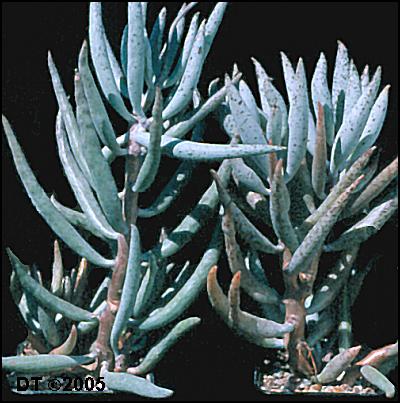
Clue: in 2¾" (7 cm)
pots.
|
Can
you give Latin names to these fifteen Adromischus photos? It is not
easy and requires experience. We start with plants in cultivation.
Use
your mouse to highlight/select invisible text between the square
brackets to see the answers.
[
A tall cylindrical leaved Adromischus is always
A.
filicaulis. This elegant form has a rough leaf-texture
when stressed, from the area NE. Clanwilliam in the Cederberg. ]
|
|
[ My only
clone of A.
humilis always remains green in
summer, but Bryan Makin achieved a wonderful red colour with this clone.
Possibly, he grew it out in the open,
not under glass. Unless flowers are observed, it is very difficult to
distinguish this from A.
fallax and even A. phillipsiae
vegetatively. ]
|
 |
 |
[ A. schuldtianus
subsp. juttae, CR1374 from near Klein
Karas in Namibia, with a nice pink wavy margin. Note the tuberous
rootstock - a characteristic of Section 2 species. Photo &
plant: Chris Rodgerson.
] |
|
[ With
long cylindrical leaves, this looks like an unusually red sample of A. filicaulis, but
did you notice the small horny margin near the tips of the leaves?
These multiple clones are a superb form of A. marianiae
"immaculatus", found by myself &
Chris Rodgerson from near Doringbos, NE of Clanwilliam. Plants:
Steven Hammer. ]
|
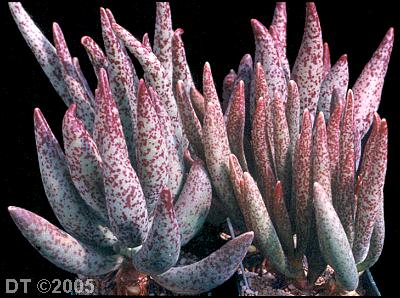 |
|
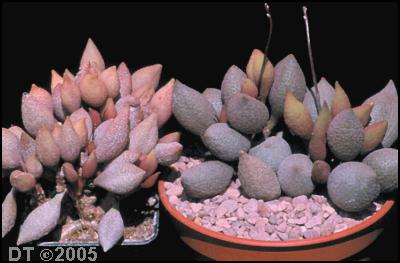
Scale: 2" (5 cm) & 3½" (9 cm)
pots.
|
[ This is
probably the easiest plant to identify in the quiz. This A. marianiae "herrei" from W.
of Maerpoort-se-berg illustrates ecotypic variation well! My parent
plant on the left has been starved in a small pot, the younger but
larger plant on the right, grown by Tom Russell, has been treated
generously - note the increase in leaf size. ]
|
|
[ This pair
of A.
marianiae "immaculatus" (found W. of Lutzville in the Knersvlakte by Alan
Hart & Ian Thwaites
) were previously my best match for habitat material of A.
geyeri P.C. Hutchison,
with unusually rounded leaf tips.
It grows strongly in winter and needs
generous waterings then.
]
|
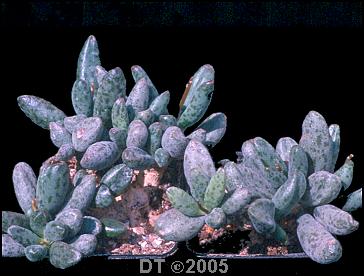
Scale: Two 2" (5 cm) pots.
|
|

|
[ Very
popular in cultivation, this heavily marked clone of A. marianiae
"hallii" was
introduced to UK cultivation by Bryan Makin and BM2075 has been
formally named after him as a cultivar. Thus it's label should read A.
marianiae 'Bryan Makin'. This was Bryan's own plant at a
BCSS Zone 6 show in 1984 and was given to him as a leaf in Sept. 1981
from the Hester Malan Nature Reserve, with the locality data "Southern
Richtersveld". ]
|
|
[
For many years, the exact origin of the
previous 'Bryan Makin' cultivar was unknown, but a whole population of
such lovely plants has now been found in the veld by Steven Hammer
& Chris Barnhill near the Anenous Pass, W. Steinkopf. Here are
four clones grown by Steve in San Diego. ]
|
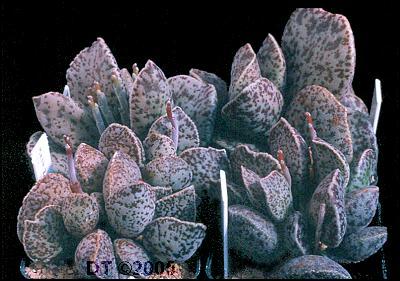 |
|
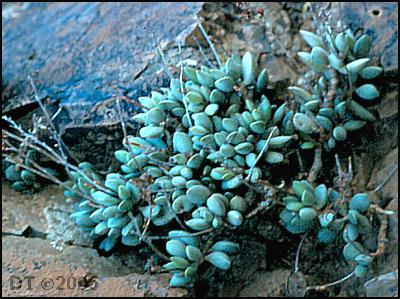
Clue: Growing at
Theekloof, S. Fraserburg.
|
Next, two more awkward photos from habitat to
identify.
[
Small Section 1 plants with elongated stems
from the W. edge of the Great Escarpment are plotted as A. filicaulis subsp. marlothii on the distribution
maps, but could equally well be called a form of A. liebenbergii. This is one of the
taxonomic puzzles still remaining.
]
|
|
[ In
habitat, it is tempting to be a little foolish and try to identify an
Adromischus with insufficient information! This did fool me - I had
used it to illustrate A. inamoenus in this web
site, but my notes show that DT4890 grew into one of those non-descript
Section 4 A. maculatus/triflorus intermediates. ]
|
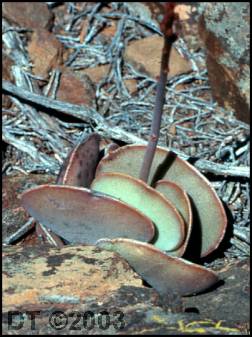
Clue: Growing SE of Willowmore. |
|

Scale: 4¾" (12 cm)
pot.
|
And finally
four distinctive Adro's in cultivation to watch out for!
[ Yes, an
Adromischus really can become this red in spring. Identifying it as a
hybrid between A. hemisphaericus & A.
marianiae is difficult unless your noticed it on the page
about Hybrids. Plant: Tom Russell. ]
|
|
[ Once
known, this distinctive form of A.
cristatus with long thin petioles (leaf
stalks) is easily recognisable. It was named as cultivar 'Indian Clubs'
when distributed as ISI 92-25, in C&SJ (U.S) vol. 64, p.87
(1992). The characteristic root hairs on the stem are only just visible
in this picture. Has anyone seen plants
like this growing in the veld? ]
|

Scale: 2¾" (7 cm) pot. |
|
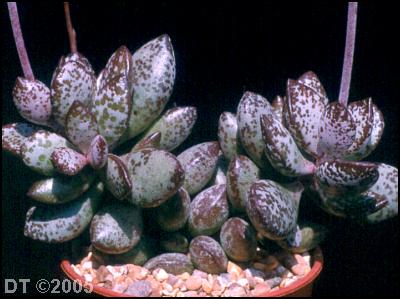
Scale: 2½" (6 cm) pot.
|
[ This handsome small
Adromischus DT3660 from Section1 has caused me much trouble. It was a
gift of leaves/cuttings from Ernst van Jaarsveld at Kirstenbosch in
1984. I recorded habitat data on a pocket tape recorder, but alas
treated it as if it contained a three-sided tape, overwriting the
information! Subsequently, I never could find matching plants at
Kirstenbosch, nor have I seen similar plants in the veld. After giving
material to nurserymen, it is widespread in UK cultivation, but will
probably remain one of the many unidentified Adros in circulation.
Plant: Tom Russell. ]
|
|
[ If only this wasn't a
fraud! This extremely rough leaved A. marianiae "hallii" is
the product of digital photographic enhancement. ]
|
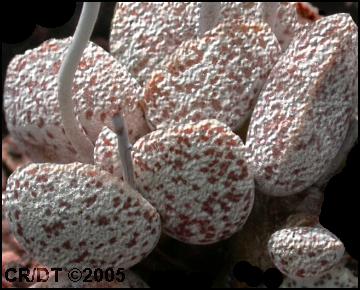 |
|
Last Updated: Feb 2005 |
 |
© 2005 Derek Tribble, London, UK |
|
|